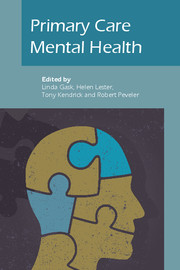Book contents
- Frontmatter
- Contents
- List of figures, tables and boxes
- List of contributors
- Preface
- Part I Conceptual basis and overarching themes
- Part II Clinical issues
- 8 Depression
- 9 Suicide and self-harm
- 10 Anxiety
- 11 Medically unexplained symptoms
- 12 Mental health problems in older people
- 13 Perinatal mental health
- 14 Child and adolescent mental health
- 15 Psychosis
- 16 Emergencies in primary care
- 17 Substance misuse
- 18 Management of alcohol problems
- 19 Eating disorders
- 20 Physical health of people with mental illness
- 21 Ethnic minorities
- 22 Asylum seekers and refugees
- 23 Sexual problems
- Part III Policy and practice
- Part IV Reflective practice
- Epilogue: Racing pigeons and rolling rocks: reflections on complex problems in primary care
- Index
12 - Mental health problems in older people
from Part II - Clinical issues
Published online by Cambridge University Press: 02 January 2018
- Frontmatter
- Contents
- List of figures, tables and boxes
- List of contributors
- Preface
- Part I Conceptual basis and overarching themes
- Part II Clinical issues
- 8 Depression
- 9 Suicide and self-harm
- 10 Anxiety
- 11 Medically unexplained symptoms
- 12 Mental health problems in older people
- 13 Perinatal mental health
- 14 Child and adolescent mental health
- 15 Psychosis
- 16 Emergencies in primary care
- 17 Substance misuse
- 18 Management of alcohol problems
- 19 Eating disorders
- 20 Physical health of people with mental illness
- 21 Ethnic minorities
- 22 Asylum seekers and refugees
- 23 Sexual problems
- Part III Policy and practice
- Part IV Reflective practice
- Epilogue: Racing pigeons and rolling rocks: reflections on complex problems in primary care
- Index
Summary
This chapter is divided into four main sections, presenting, in turn, the primary care management of the commonest mental health problems in older people: delirium, depression, dementia and delusions (the first three of these are compared in Table 12.1). The presentation and management of a typical case are illustrated for each. Although the discussion largely refers to the UK context and the general practitioner (GP), the majority of it will apply internationally and to primary care physicians (and indeed other professionals) more generally.
Delirium
Clinical presentation
Delirium is a syndrome comprising disturbance of consciousness (often manifest as impaired attention or concentration), cognitive deficits (such as memory, orientation or language problems), disturbed sleep–wake cycle, associated features such as delusions or hallucinations (especially visual) and behavioural disturbances (such as agitation or apathy) and alterations in affect, notably fear (Table 12.1).
The onset is often sudden (hours or days) and fluctuation is a hallmark. A useful mnemonic is the four ‘I's (Crausman, 2004):
intermittent impairment of cognition
inattention
incoherent thought
impaired consciousness.
Delirium is synonymous with ‘acute confusional state’ (see Chapter 16).
Case 1. Delirium: Marjorie
The GP is called to see an 83-year-old lady, Marjorie, who lives in a residential home and who has quickly become confused, withdrawn and irritable. She has wandered out of her room, awake, for the past three nights.
She has a history of diabetes, ischaemic heart disease, peptic ulcer and recurrent urinary tract infections.
Her medication comprises gliclazide, digoxin, aspirin, ramipril, atorvastatin, thyroxine, omeprazole and paracetamol.
The nurse in charge has asked the GP to see her because Marjorie is being disruptive.
What does the GP need to consider in relation to assessment, diagnosis and management?
Two main presentations are recognised:
• hyperactive delirium (hallucinations, delusions, agitation and disorientation)
• hypoactive delirium (cognitive impairment with apathy or withdrawal, less often accompanied by hallucinations and delusions).
The latter form can easily be overlooked in older patients.
- Type
- Chapter
- Information
- Primary Care Mental Health , pp. 174 - 197Publisher: Royal College of PsychiatristsPrint publication year: 2009

